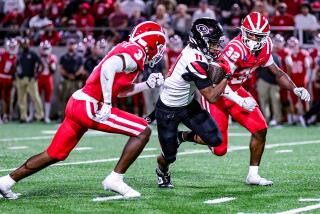As a Pass-Catcher, Darnay Scott Is a Handful
- Share via
SAN DIEGO — When little Johnny is maybe in ninth or 10th grade, it is time to sit him down and determine what he wants from life and where he should go to find it.
You know, if he wants to be a general, you send him to West Point. If he likes the water, he goes to Annapolis to be an admiral. If he wants to be a politician or maybe ambassador to Sri Lanka, send him to Harvard. Perish the thought, should he want to be an attorney, keep him home at USD. Hopeful hippies can get a good start at Cal . . . and they don’t even have to finish.
Should Johnny’s bent be athletics, you send him to Penn State to be a linebacker, Brigham Young to be a quarterback, Michigan to be a tackle or UCLA if he happens to be 7 feet tall.
If Johnny wants to catch a football, you send him to San Diego State.
Be they wide receivers or tight ends, kids come out of SDSU with a future. It started with Skeets Quinlan in the early 1950s and continued through the likes of Haven Moses, Gary Garrison, Isaac Curtis, Webster Slaughter, Don Warren, Ken Burrow, Rob Awalt, Duke Fergerson, Alfred Jackson, Clint Sampson, Phil Smith, Ron Smith and, though he is now a rookie on injured reserve, Patrick Rowe.
And the best, the very best, might be a kid who is all of a sophomore with the 1992 Aztecs.
His name is Darnay Scott. He wears No. 6, as in six points. He’s the one who looks like he’s running a 4.2 40 when he is standing still. If defensive backs could ever get close to him, they would notice he has a gold “D” on an upper front tooth. They probably see it when he’s smiling, or drooling, at the line of scrimmage.
Scott could be a forgotten man on this SDSU team, because there’s this other guy named Marshall Faulk. Both made the 1991 varsity as true freshmen, but one was an All-American and the other a backup--behind Rowe--receiver.
“I think I could probably get more recognition if I wasn’t on the same team with Marshall,” Scott said. “He did so much as a freshman and I only played a lot in a couple of games. But I like being the man they look at after they look at him. And he’s my best friend.”
It’s getting to the point where folks won’t be noticing Scott after they look at Faulk, but rather because they are looking at Faulk. It’s like the baseball scout who goes to a game to see a pitcher and realizes the shortstop, too, is an outstanding talent. Scott, in that sense, benefits from Faulk, because it has been a while since anyone tuned into SDSU to see anybody.
Scott’s coming-out party, so to speak, was in that 52-52 tie with BYU last year, when he reeled in scoring passes of 75 and 79 yards from David Lowery. He crashed onto the scene a little later than his buddy, but with just as much pizazz.
When Scott trots out wide and takes his stance, leaning slightly forward and looking back at Lowery, his is an ominous presence for a defense that is already wondering how it’s going to stop Faulk.
As UCLA Coach Terry Donahue said: “You’re always on nerve’s end concerned about what he’s going to do.”
And how to keep him from doing it.
Texas El Paso determined last week that it would stop Faulk. It threw everyone but the Dean of Humanities onto the line of scrimmage. It worked, if you want to call holding Faulk to 156 yards really holding him, which may be true in relation to standards he has set.
However, this game plan frequently left Scott one-on-one with a cornerback. Lowery tested this defense on the Aztecs’ first play from scrimmage, a modest little hitch pass to his favorite receiver.
“That’s just setting them up,” Scott said. “We want to see if they’ll come up and bite.”
They bit.
Scott and Lowery both knew what the next play would bring.
“I gave David a look,” Scott said, “and he looked at me.”
Nothing needed to be said. The Aztecs’ second play covered 71 yards and Scott was in the end zone.
How would Scott like to be that defender, sitting out there by himself?
“I wouldn’t want to be him,” he said. “I wouldn’t want to play me head-to-head. I’d want help.”
Therein lies the dilemma of defensive coordinators. Air Force has to try to figure out how to ground these guys at the stadium--and on national television--this Saturday.
“I think I’d take people off the line and double the receivers,” Scott said. “And not just me. Keith Williams is a big-play receiver and you saw last week what DeAndre Maxwell can do. If they stack nine guys to stop Marshall, that’s not going to work.”
He was smiling such a big smile that the “D” on his front tooth was absolutely aglow. He knew what he was saying. He knew he was suggesting that the defense spread itself all over the field to stop this passing attack. He knew also that this would open running lanes for his buddy, who doesn’t need much of an opening.
When you play SDSU, you don’t choose what to stop as much as what there’s no way you’re going to stop. Then you hope what you’re “stopping” at least slows down.
Historically, at San Diego State University, wide receivers aren’t the guys you decide to pick on.
More to Read
Go beyond the scoreboard
Get the latest on L.A.'s teams in the daily Sports Report newsletter.
You may occasionally receive promotional content from the Los Angeles Times.










